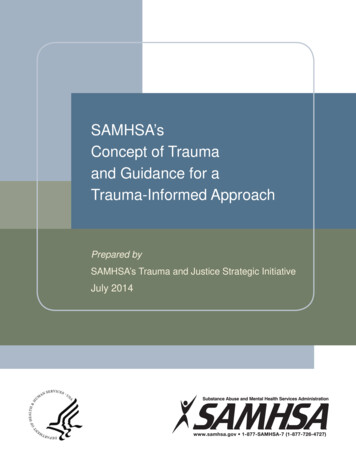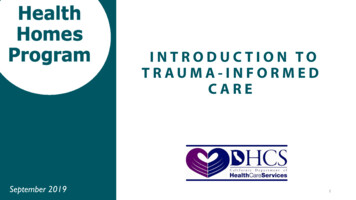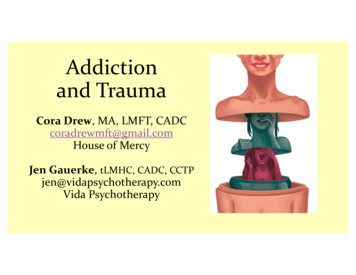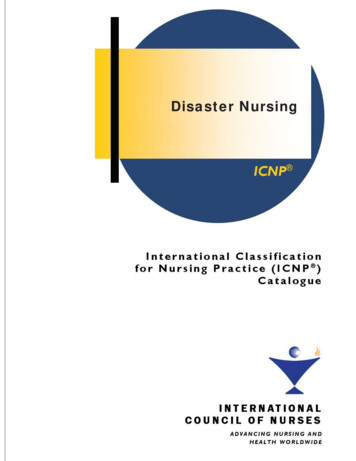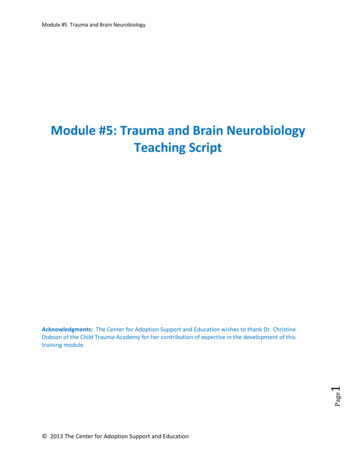
Transcription
Trauma nursingProfessional development frameworkApril 2019
Trauma Nursing – Professional Development FrameworkContentsIntroduction3The Framework4Current state5Core trauma nurse functions6Advanced career options10Future state12Implementing this framework13Appendices14Appendix A: Trauma nurse professionaldevelopment working group14Appendix B: References14Appendix C: Current state survey results15Appendix D: Trauma courses17Appendix E: Nursing Council of NZ18Appendix F: RACS guidelines for nursing roles19Appendix G: Funding sources20Appendix H: Professional trauma organisations21Glossary221
IntroductionIntroductionIn 2018 a working group of trauma nurses was set up to guide the development of this professionaldevelopment framework. The group comprised representation from hospitals across the country, fromsmall to large hospitals, and a range of experience from new to role to experienced (Appendix A).The group identified four key areas of focus which form the basisof the framework:1.Current state2.Core trauma nursing skills and training3.Advanced trauma nurse career options4.Future trauma nursing stateThis framework does have limitations and in particular we notethe need to build the capacity and capability of the Maori traumanursing workforce, incorporating Te Tiriti o Waitangi to addressthe burden of trauma for Maori across all aspects of the traumasystem, and providing guidance on the level of resourcing inline with caseload. Future revisions of this framework shouldincorporate these aspects. This is the first time a trauma nurseprofessional development framework has been developed inNew Zealand. We envisage this framework will be amended intime as our understanding of the role evolves and our traumasystem matures.Notwithstanding these limitations, this early work is an importantstep to building a high-performing trauma nursing workforce inNew Zealand.About major trauma in New ZealandMajor trauma accommodates those patients that incur injurieswhich have a threat to life. There are approximately 2,000 majortrauma events per year and include injuries ranging from seriousinjury such as pelvic fractures, through to catastrophic injuriessuch as traumatic brain injury or mangled limbs which requireintensive life-long care.The burden of trauma is distributed unequally across NewZealand, and between population groups. Some regions have adisproportionally high incidence of major trauma and variationin the causes of injury. The burden of major trauma for Maori aisnearly double that for non-Maori, and the high incidence rate foryoung Maori males is of concern.The National Trauma Network (the “Network”) was set up in2012 to drive quality improvement across the trauma systemand bring us into line with contemporary trauma systemsinternationally. Sponsored by ACC the Network has a strongclinical focus as the opportunity to improve outcomes for majortrauma patient is largely in pre-hospital and hospital care. Bestpractice care results in fewer deaths and decreased life-longinjury, and a more efficient health service.There are variable levels of maturity in the trauma systems acrossthe country, and many nurses and doctors are relatively newto role. The intent of this framework is to support a commonunderstanding and consistent implementation of the traumanurse role.3
Trauma Nursing – Professional Development FrameworkThe framework4eAdvserreatti o nTraumanursesopCULTURAL COCurrentstCYTENPEMDERSHIPLEAThe New Zealand Council of Nursinghas published an excellent guidelinefor nurses which covers cultural safety,the Treaty of Waitangi, and Maori Healthand Nursing Practice. All District HealthBoards provide cultural competencytraining and all trauma nurses areencouraged to undertake this and readthe Council of Nursing publication (seereferences on page 14)erCultural competence training assistsnurses to provide a more accessibleand welcoming service and has beenidentified as a key skill to ensurenurses are consistently able to providepatients and their whānau withhealth information in a way they canunderstandtuThe burden of trauma for Maori issignificantly higher than for otherpopulation groups. The trauma nurse’srole is to provide the best care possibleto support recovery, and this includesproviding care which is culturally safeand competent.FuThe professional development frameworkdescribes the four areas of focus as shownin the diagram. Two additional elements;work culture and leadership skills aredescribed and are relevant across allareas of the professional developmentframework.nur Cores in tgfa sum ionra nctuThe ProfessionalDevelopment FrameworkCULTURAL SAFETYAND COMPETENCYtestaK CULTUREORWGrowing the trauma nursingworkforce is key to achievingour goal of a high performingtrauma system in New Zealand.It is our ambition to developtrauma nursing as its ownspeciality and achieve highlyqualified specialist traumanurses in each region.andcecaWORK CULTURELEADERSHIP SKILLSA collaborative work culture is key toan effective trauma system. We wantto foster a strong sense of collegiality asmost trauma nurses are in sole positionsin their hospital. We also want to builda workforce which is innovative andthinks critically. We will do this by:Trauma nurses are leaders in their fieldand there are skillsets which are usefulfor all trauma nurses in addition toclinical skills. These include: Leadership and critical thinking Providing mentoring to new traumanurses Presentation Business writing Meeting annually Developing forums to shareknowledge and experience so webecome fast adapters of effectiveinnovationsAnalytics such as basic functions inExcel Supporting trauma nurses to growin their role Encouraging excellenceBy working together we can promotetrauma nursing as a career of choiceand cultivate a positive environmentin our trauma teams.These include:Uptake of training in these areas isstrongly encouraged as they will beenormously useful in promoting traumacare and the on-going investment intrauma nursing. Most DHBs providetraining in these areas as part of inhouse training.
This Framework Current stateCurrent stateIn early 2019 we undertook a survey of trauma nurses to understand the current state and set a baseline.The detailed results are in Appendix C and summarised here.The majority of the nursing workforce is in theA significant proportion40-60 year age group,and are female.(68%) has been in their roleless than 3 yearsThere areand reflects the start of data collection in all DHBs26 postgraduate qualifications(some have more than one) and afurther seven are currently studyingtoward a postgraduate qualification.Almost all have done the AIS course (93%).Nearly80%as required in the Ministry of HealthRegional Service Planning guidance.There is a good level of interestin presenting at conferencesand in research.of the trauma nursing workforce isThe main support to encourage nurses in these areasin a designated senior nursing role,includes training, mentoring, and time.such as Clinical Nurse Specialist.The average FTE is 0.56,ranging from 0.1 to full time.The results of this survey are in line withthe expected result considering overhalf the country implemented traumanursing in the past three years.In some hospitals, and particularly the smaller centres,The results will form the baseline for future surveysthe trauma nurse role is focussed only on data collection.to understand how the trauma workforceIn other hospitals, there may be more than one trauma nursehas evolved over time.There are no Nurse Practitioners in trauma roles.in role. These factors have an influence on the FTE average.5
Trauma Nursing – Professional Development FrameworkCore traumanursing functionsThere are four key functions which are core to all trauma nursing positions. While many trauma nurses arecurrently not sufficiently resourced to provide all these functions, by setting out a common expectationwe can work towards increasing resourcing where needed. These skills are in addition to undergraduatetraining and clinical experience typically in Emergency Departments, Intensive Care, or surgical services.Data collection and inputThe minimum requirement is thecollection of the NMDS for major traumaon all trauma patients with an InjurySeverity Score (ISS) 13 or who diedin hospital with an ISS 12. This datais uploaded to the New Zealand MajorTrauma Registry (NZ-MTR) within 30 daysof the patient discharge. Data collectingtrauma nurses are also expected to fixany errors which are identified throughthe data quality assurance process. Somehospitals may decide to collect on alltrauma patients and/or a wider dataset.The process of data collection presentsa good opportunity to assess thepatient and review their care for missedinjuries or processes. It also supports theunderstanding of local trends around thecircumstances of the injury which can helpinform trends such as a particular activityor location where injury occurs. Thisinformation can in turn be passed ontoinjury prevention initiatives.Training6 AIS course with refresher every three years Training on the use of the NZ-MTR Other requirements Signing of the NZ-MTR Data Access Policy
Core trauma nursing functionsNursing case managementTrauma patients often require complex, coordinated care through their hospital stay. Nursing case managementparticularly of the polytrauma patient is an excellent approach to ensure patients receive optimal care tailored to theirneeds. Evidence shows that case management can be effective in reducing overall length of hospital stay, intensive carebed hours, and improved patient satisfaction.Trauma case management is described as: --Coordinating care to--take responsibility for overall patientmanagement across a continuum of care andbeing the point of care coordinator for thepatient/family/whanau/staff--arrange multi-disciplinary meetings to discusspatient progress, issues and goals. engaging the patient and their whanau toascertain the background of the incident, theirsocial situation, and relevant clinical history andparticularly psych history. It is also to discuss likelyreferrals, issues relevant to the patient and theclinical management planLiaising with--clinical team(s) on clinical issues, intra-hospitaland inter-hospital transfer requirements e.g. wardadmission, single room for TBI management,--ensuring trauma guidelines are followed--supportthe management of the complextrauma patient--allied health for early rehabilitation assessment--initiate treatment care plans--appropriate teams such as psych support, drugand alcohol, orthotics, respiratory, etc. to provideholistic care--ACC for early coverReviewing the patient notes and radiology/pathology results to--assess for missed injuries--check for pain control, adjuncts such as splints/braces, pressure area care etc--assess for complications--ensure correct local, regional and nationalpolicies have been followed e.g. C-Spinemanagement, blunt chest protocol, NationalSpinal Cord Injury policy.--ensure tertiary survey is done, or undertakingthe tertiary survey if competent Discharge and rehabilitation planningTrainingThere is currently no formal training for trauma casemanagement. Mentoring from colleagues is a goodway to learn including visits to or from sites withexperienced trauma case managers.7
Trauma Nursing – Professional Development FrameworkPerformance improvementPerformance improvement in trauma describes the ongoing critical analysis of clinical care and processes usingstructured methodology.Within the next five years we aim to implement aconsistent approach to performance improvement inevery hospital. At minimum it is envisaged to includebut not be limited to:8 Mortality review with a particular focus on death dueto haemorrhage and multi organ failure as these arelargely preventable Process indicators: Performance improvement initiatives tailored to thelocal context Auditing the rate of under and over triage of traumacall activationPerformance Improvement is given a priority intrauma care because it is directly related to improvingoutcomes for patients. For example, good performanceimprovement is designed to identify and addresscomplications. The overall intent is to achieve a systemwhich consistently provides optimal outcomes forpatients and supports their return to living and work assoon as possible.--time from scene to first hospital--number of transfers to definitive care--time to index CT if GCS 9Training--EToH collection TOPIC training – the availability of this is tobe determined Quality Improvement training availablethrough HQSC
Core trauma nursing functionsTraining and educationThe fourth core component is trainingand education in trauma. This includeseducating: The patient and whanau in traumacare, encompassing treatmentpathway, support post-discharge,and injury prevention Clinical colleagues includingpre-hospital, referring hospitals,rehab providers Hospital management The community, such as engaging inInjury Prevention initiativesProfessional training courses are anexcellent way to up-skill and keep upto date with the latest developments.Courses can be trauma specific andthe most common ones are referencedin Appendix D, as well as attendingconferences and online courses.9
Trauma Nursing – Professional Development FrameworkAdvanced traumanursing optionsTrauma nurses with advanced skills and training are recognised as subject matter experts in their field,and have a strong national and international reputation. Nurses wanting to develop their skills in traumahave options, which are not mutually exclusive of each other. A range of skills are usually required such asthe ability to write clearly and concisely, negotiation skills, presentation skills, and basic analytical ability.Personal attributes are just as important to show leadership through example and influence, and toencourage continual development through training.Advanced clinical practice –Nurse Practitioner (NP)Becoming a NP is the recognised pathway to achievingadvanced clinical practice and results in a recognisedqualification and scope of practice. Advanced clinical skills couldinclude FAST scanning, prescribing, tertiary survey, outpatientclinics, telehealth, etc.There is good level of evidence which shows NPs (or equivalent)are effective at reducing length of stay in hospital and IntensiveCare.It is also suggested that NPs develop associated skills such asbiostatistics, business writing, negotiation, and presentation skillsas these are useful skills for any leader.There are no Trauma NPs currently in New Zealand, and efforts toachieve one in each of the regions will be dependent on DHBssupport for these roles.ResearchTrauma nursing research is an incredibly broad area, broadlydivided into several topics: Injury prevention Pre-hospital care Acute care population groups including Maori, the elderly,and the young Trauma systems and health policy Trauma nursing education and administrationExpressing an interest in research is a good way to start, and thiscould initially include participating in a research study led byan experienced researcher and/or undertaking post graduateresearch work. In most instances trauma data will be used andthis is an opportunity to offer participation to the coordinatingresearcher. More experienced researchers will initiate and leadresearch projects.Building relationships with academic researchers fromuniversities is an excellent way to undertake research particularlyif relates to an area of interest to the academic. Doingbackground work on the researcher and their publications isuseful before approaching them.Publication in reputable journals is the gold standard for anyresearcher and some of the excellent journals include theNew Zealand Medical Journal, the International Journal ofTrauma Nursing, and Injury, and Nursing Praxis in New ZealandAt this stage there is a dearth of trauma nursing research specificto New Zealand.10
Advanced trauma nursing optionsAcademicManagement of trauma servicesTrauma nurses in academia enjoy a mix of teaching, clinical work,and research. This pathway typically requires a Master’s degree atminimum.Progressing to be a manager in a trauma or related service is aneffective way to influence optimal trauma care. Managers aretypically involved in funding decisions and can influence thestrategic direction of trauma services. They are also responsiblefor staff including professional development and training.A handful of nurses across Australasia have successful academiccareers and are an excellent resource to trauma nurses wishingto enter this pathway.Advanced Performance ImprovementPerformance improvement is the cornerstone of anytrauma programme. Advanced practitioners in performanceimprovement will be able to teach the methodology to traumaclinicians, provide technical and mentoring support, anddemonstrate the benefits.Most hospitals will provide some management support to newmanagers. It is also helpful to develop a range of skills such asleadership training, business writing, presentation skills, andanalytical skills.Further information on postgraduate training and fundingsources can be found in Appendices D, E and G.The Health Quality and Safety Commission offers a range oftraining. There is also the TOPIC Instructor programme whichwe are seeking clarity on for international faculty.EducationBecoming a trainer is an excellent way to become an advancedpractitioner, and again the range of topics is vast. Traumanurses interested in developing in this area will need to do theirhomework as the requirements for each course differs.Many hospitals also have clinical nurse educator roles whichprovide on the job training and guidance.11
Trauma Nursing – Professional Development FrameworkFuture stateOver the next five years we hope to progressively introduce the four core functions of the trauma nurseinto all hospitals across New Zealand. These functions may be applied differently depending on thecaseload.Over the same timeframe it is our aspiration to achieve: 4 Trauma NPs, one in each region 1 AIS trainer, who will support training in NZ and Australia 2 TOPIC and/or performance improvement trainers an increase in the Maori trauma nursing workforceThe option to develop Speciality Practice Nursing Standards for trauma nursing could be explored further. Specialty standards addresswhat nurses providing care within this specialty area must know and be able to do in relation to the identified aspects of care beyond thatexpected of every competent registered nurse. The UK has established standards which could be used as a starting point. The decision toprogress speciality standards should be made in conjunction with Australian colleagues, and consider the benefits against the time andeffort required.It is also our ambition that all acute hospitals will be staffed in line with the RACS guidelines for trauma hospitals. The RACS guidelinesarticulate the functions specified based on the capability and caseload of the hospital. The table below sets out the scope of practice andindicative resourcing requirements based on trauma caseload.RACS trauma level hospitalNursing scope of practiceIndicative resourcesLevel 1 and major traumacaseload 150 pa Case Management Nurse Practitioner Performance improvement Trauma senior nurse Patient management Outpatient clinic Trauma specialist nurse Research Admin support Education Protocol development Service development Regional support National interests Case Management Trauma senior nurse Performance improvement Trauma specialist nurse Research Education Service development including patient management,protocol development and national interests Case Management Trauma specialist nurse Performance improvement Research Education Patient management Protocol developmentLevel 4 Case ManagementStaging hospitals Resuscitation Emergency ManagementLevel 2 and major traumacaseload 50-150 paLevel 3 and caseload 0-50Further information on the RACS guidance can be found in Appendix F.12
Future state Implementing this frameworkImplementing thisframeworkThe following recommendations are presented by the working group to progressively achieve the futurestate trauma nursing workforce.RecommendationLeadaUpdate this document each 2-3 years including the workforce surveyNational Trauma NetworkbProgressively integrate the core trauma nursing functions into job descriptions as appropriateto the size of hospitalAll trauma teamscWork with hospital management particularly in the major trauma hospitals to encourage thecore functions to be adequately resourcedAll levels of the trauma systemdPromote mentoring for trauma nurses including:All levels of the trauma systemAll hospitals1. case management to support a consistent approach across NZ2. performance improvement initiatives3. identifying nurses with potential to grow in role4. research, presentations, and leadership skillseAdvocate RACS to include nurses as participants in Early Management Severe Trauma coursesEveryonefEngage with Maori nursing leaders to develop strategies to improve the cultural competencyand safety for the trauma nursing workforce, and to encourage Maori nurses to specialise intrauma nursing.All trauma nursesgTest the appetite for establishing speciality standards for trauma nursing, in discussion withAustralian colleagues.National Trauma NetworkhExplore the opportunities for professional development in trauma, starting with the core skillsand progressing to areas of special interest.All trauma nursesiDevelop nationally or regionally consistent guidelines for nurses such as a toolkit comprising:National Trauma Network Orientation checklists for new trauma nursesAll regions Contact list for national trauma nurses Examples of job descriptions13
Trauma Nursing – Professional Development FrameworkAppendix A:Trauma nurse professionaldevelopment working groupWorking group memberOrganisationMelissa EvansCanterbury DHBWendy DavieCanterbury DHBKatrina O’LearyMidland Trauma SystemJaki BoyleTairawhiti DHBBronwyn DenizeWaikato DHBJennifer DorrianWaikato DHBMatt SawyerAuckland DHBPamela FitzpatrickAuckland DHBSiobhan IslesNational Trauma NetworkAppendix B: ReferencesChristmas, A. B. and Reynolds, J. and Hodges, S. and Franklin, G. A.and Miller, F. B. and Richardson, J. D. and Rodriguez, J. L.Physician extenders impact trauma systems. J Trauma, volume 58,number, 917-20. 2005College of Nurses. Principles and standards for electronic portfoliodesign and development. 2017Crouch, R. and McHale, H. and Palfrey, R. and Curtis, K. The traumanurse coordinator in England: a survey of demographics, roles andresources. Int Emerg Nurs, Vol 23, No. 1. 2015,Curtis, K. and Donoghue, J. The trauma nurse coordinator inAustralia and New Zealand: a progress survey of demographics, rolefunction, and resources. J Trauma Nurs Vol 15, No 2. 34-42. 2008.Curtis, K. and Leonard, E. The trauma nurse coordinator inAustralia and New Zealand: demographics, role, and professionaldevelopment.J Trauma Nurs Vol 19, No 4, 214-20. 2012Leonard, E. and Curtis, K. Are Australian and New Zealand traumaservice resources reflective of the Australasian Trauma VerificationModel Resource Criteria? ANZ J Surg, Vol 84 No 7-8, 523-7. 2014National Nursing Consortium. Guidance for the Development ofSpecialty Practice Nursing Standards. 2017Nursing Council of New Zealand. Guidelines for Cultural Safety,the Treaty of Waitangi and Maori Health in Nursing Education andPractice. 2011RACS Guidelines for a structured approach to the provisionof optimal trauma care. https://www.surgeons.org/media/17053260/doc 2012-09-14 guidelines for a structuredapproach to the provision of optimal trauma care.pdf14
AppendicesAppendix C: Results of trauma nurse survey 2019A current state survey was undertaken in January2019 and is envisaged to form the baseline forfuture survey’s. The questions are based on aprevious survey led by Kate Curtis in Australasiain 2013 and adapted as we wanted to explorethe specific support trauma nurses needed tobe more involved in research, education, andpresenting at conferences etc.5. Trauma coursesAIS – basic courseAIS – accreditationAIS – instructorEarly managementTrauma Nurse Core CourseThe response rate was 100% with all 27 trauma nurses in NewZealand participating.TOPIC course (Trauma .The results of the survey are as follows:Other (please specify)1. Age0 45%: 40 – 50 years 32%: 50 – 60 years 23% either 40 or 60 years1020304050607010080901006. Level of practice6 Staff nurse2. Gender 19 Trauma Nurse Coordinator / nurse specialist 0 nurse practitioner 2 other90% female3. Region7. How many years in roleNorthern Average 3.15 Range 1 year to 13 yearsCentral 65% in role 2 years or lessSouth Island8. FTE in trauma roleMidland1090(%) 0802030405060708090100(%) Average .56 FTE Range .1 to 1 FTE9. Hours per week are spent on:4. Postgraduate qualificationsTrauma data collectionAnswer choicesResponsesGraduate orate0.00%0Other (please specify)25.93%7Clinical activitiesEducation and trainingPerformance improvementTotal Respondents: 27Trauma adminA further 7 are studying toward Diploma (4), Masters (2)and degree (1)Conducting researchCollaboration hospital010203040506070(%)15
Trauma Nursing – Professional Development Framework10. Number of conferences per year17. Are you involved in research? 85% 1- 2 per year64% NO 1 % 3 or more34% YES 14% none18. Have you ever published?11. Role at conferences80% No publications 5 presented16% 1 – 2 publications 22 delegate4% 3 publications12. Study leave? 19. Are you interested in becoming involvedin research?85% received study leave 13. Days study leave 86 days in total Average 3.4 days20. What would help you become involved inresearch?Mentoring14. Who paid?TrainingYouTimeYour institutionSupport with data analysisACC Incentive FundOther(Please specify)Other (please specify)0102030405060708090100(%)15. Have you ever presented at a conference? 8 yes16. What would encourage you to present?MentoringPresentation trainingStudy leaveConsent forpresentationOther(Please specify)01020304050(%)1696% yes or maybe607080901000102030405060708090100(%)It is envisaged this survey will be repeated at various intervals todemonstrate the change in the trauma nursing workforce overtime. The same parameters should be applied in future surveys.Additional parameters should be considered such as ethnicity todemonstrate changes in the ‘by Maori, for Maori’ trauma nursingworkforce.
AppendicesAppendix D: Trauma coursesLinks to most of the courses below are available on the website www.majortrauma.nz/events.Abbreviated Injury Scoring (AIS) Understand the structure, organization and contents of theAbbreviated Injury Scale Abstract injury data from medical charts Rule out information that is not codeableThe TOPIC course is taught in a one day interactive modularformat, customized to best meet the needs of the individualtrauma care provider participants who have varying levels ofexperience with trauma performance improvement. The courseoffers practical application for all Levels of trauma centres,from entry level to mature phase of program development.The modules are taught with a focus on didactic, operationaldefinitions, sample tools, case study examples and take homepoints. Distinguish between injuries and outcomeshttps: //www.traumanurses.org/topic Apply injury coding rules and guidelines specific to eachbody regionNZ contact: info@majortrauma.nz Apply rules for calculating the Injury Severity Score (ISS) formultiple body region injuriesAIS and Injury Scoring: Uses and Techniques course objectivesare to:Courses are run on ad hoc in New Zealand and Australia. It isexpected each data collector will do an AIS refresher every e-ais/training-courses/NZ contact: info@majortrauma.nzAIS certificationCertification is part of a credentialing process and is anindication of current competence in a specialized area ofpractice. Board Certification provides formal recognition of AIScoding knowledge and application. Experienced AIS coders areencouraged to obtain certification. Once certified, individualsmust retest every 5 years to maintain their CAISS certification.AIS trainer and member of AAAM FacultyThe pathway to be a trainer and faculty member includespassing the basic AIS course, becoming certified, and deliveringtwo training sessions under supervision. Admission to thefaculty is then assessed based on teaching ability and contentknowledge. Trainers are required to teach on minimum twocourses every two years.In NZ we are aiming to have one trainer admitted by 2019. Wedo not expect to have sufficient courses to warrant more thanone trainer.Trauma Outcomes PerformanceImprovement Course – TOPICThe TOPIC course is taught to all members of the trauma systemteam who participate in the ongoing assessment, evaluationand improvement of trauma care. The Society of Trauma Nurses(US) has developed the Trauma Outcomes and PerformanceImprovement Course in response to the need for education andbetter understanding of the Performance Improvement processin trauma care. TOPIC focuses on the ongoing assessmentof the continuum of trauma care with a structured review ofprocess and discussions of strategies to monitor trauma patientoutcomes.Trauma Nursing Core Course - TNCCThe optimal care of the trauma patient is best accomplishedwithin a framework in which all members of the trauma teamuse a systematic, standardized approach to the care of theinjured patient. Emergency and trauma nurses are essentialmembers of the trauma team. Morbidity and mortality of traumapatients can be significantly reduced by educating nurses toprovide competent trauma care.Trauma nursing as a discipline refers to the process and contentof all the different roles nurses have in the care of the traumapatient. Knowledge is the core of any discipline. The purpose ofTNCC is to pres
trauma nursing. Most DHBs provide training in these areas as part of in-house training. Growing the trauma nursing workforce is key to achieving our goal of a high performing trauma system in New Zealand. It is our ambition to develop trauma nursing as its own speciality and achieve highly qualified specialist trauma nurses in each region.





